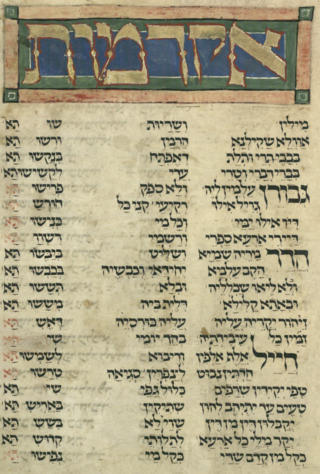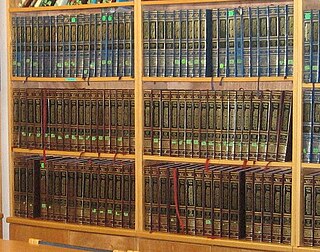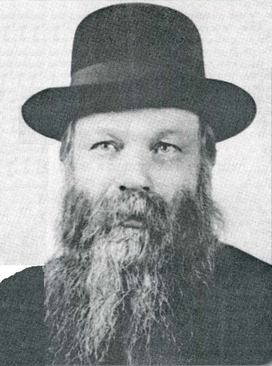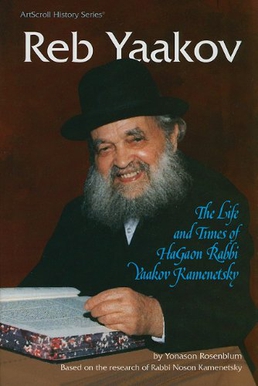Related Research Articles
ArtScroll is an imprint of translations, books and commentaries from an Orthodox Jewish perspective published by Mesorah Publications, Ltd., a publishing company based in Rahway, New Jersey. Rabbi Nosson Scherman is the general editor.

Yaakov Kamenetsky, was a prominent rabbi, rosh yeshiva, posek and Talmudist in the post-World War II American Jewish community.

Yeshiva Torah Vodaas is a yeshiva in the Flatbush neighborhood of Brooklyn, New York.
Rabbi Nosson Scherman is an American Haredi rabbi best known as the general editor of ArtScroll/Mesorah Publications. He is widely considered to be the father of modern-day English Torah literature.

Rabbi Meir Zlotowitz was an Orthodox Jewish rabbi, author and founder of ArtScroll Publications.

Yosef Chaim Shneur Kotler was an Ashkenazi Orthodox rabbi from the Lithuanian movement and rosh yeshiva of Beth Medrash Govoha in Lakewood, New Jersey from 1962 to 1982. During his tenure, he developed the Lithuanian-style, Haredi but non-Hasidic yeshiva into the largest post-graduate Torah institution in the world. He also established Lakewood-style kollels in 30 cities, and pioneered the establishment of community kollels in which Torah scholars study during the morning and afternoon hours and engage in community outreach during the evenings. Upon his death, he had served as the Lakewood rosh yeshiva for exactly the same amount of time as had his father, Rabbi Aharon Kotler, the founding rosh yeshiva of Beth Medrash Govoha: nineteen years, seven months, and one day.
Yedid Nefesh is the title of a piyyut and zemer. It is usually sung on Shabbat.

Akdamut, or Akdamus or Akdamut Milin, or Akdomus Milin, is a prominent piyyut written in Aramaic recited annually on the Jewish holiday of Shavuot by Ashkenazi Jews. It was penned by Rabbi Meir bar Yitzchak of Orléans, who was a cantor in Worms, Germany,. Akdamut consists of praise for God, His Torah, and His people.
Jewish commentaries on the Bible are biblical commentaries of the Hebrew Bible from a Jewish perspective. Translations into Aramaic and English, and some universally accepted Jewish commentaries with notes on their method of approach and also some modern translations into English with notes are listed.
Erelim, is a class of angel whose existence is derived from a verse in the book of Isaiah regarding the impending invasion of Jerusalem by Sennacherib during the reign of King Hezekiah.

Shmuel Yaakov Weinberg, known as Yaakov Weinberg was an Orthodox Jewish rabbi, Talmudist, and rosh yeshiva (dean) of Ner Israel Rabbinical College in Baltimore, Maryland, one of the major American non-Hasidic yeshivas. Weinberg was also a rabbinical advisor and board member in Haredi and Orthodox institutions such as Torah Umesorah, Agudath Israel of America and the Association for Jewish Outreach Programs.

Nosson Meir Wachtfogel, known as the Lakewood Mashgiach, was an Orthodox rabbi and long-time mashgiach ruchani of Beth Medrash Govoha in Lakewood, New Jersey. He also helped establish branches of the Lakewood Yeshiva in dozens of cities, and opened a combination Torah study and Orthodox outreach centers in the United States and other countries.

The Schottenstein Edition of the Babylonian Talmud is a 20th-century, 73-volume edition of the Babylonian Talmud featuring an elucidated translation and commentary, and published by ArtScroll, a division of Mesorah Publications.
Vichna Kaplan was a Russian-born American Orthodox Jewish teacher and school dean who, together with her husband Rabbi Boruch Kaplan, brought the Bais Yaakov movement to America. A prize pupil of Sarah Schenirer, the founder of Bais Yaakov in Poland, Kaplan opened the first Bais Yaakov High School in Williamsburg, New York, in 1938. She later opened the first Bais Yaakov Teachers Seminary (1941), which provided teachers for all Bais Yaakov schools that subsequently opened in America and Israel.
Igros Moshe is a nine-volume series of halakhic responsa by Rabbi Moshe Feinstein. The first seven volumes were published during Rabbi Feinstein's lifetime, while the remaining two were published posthumously in Jerusalem.
Shmuel Halevi Schecter was a Canadian–American Orthodox Jewish rabbi, educator, and author. Born in Quebec and raised in Baltimore, he traveled to Eastern Europe to study at the Mir Yeshiva as a teenager and at the Kelm Talmud Torah as a young married man. In 1940 he returned to the United States, where he was a co-founder of the first kollel in America, Beth Medrash Govoha, in White Plains, New York. He was a Torah educator in New York and Boston for more than 50 years, and served as dean of Mesivta Toras Emes in Brooklyn. He published a commentary on Orchot Chaim LeHoRosh, a musar work.

The Lomza Yeshiva was an Orthodox Jewish yeshiva in Łomża, Poland, founded by Rabbi Eliezer Bentzion Shulevitz in 1883. Rabbi Yechiel Mordechai Gordon served as the yeshiva's rosh yeshiva for many years, and Rabbi Moshe Rosenstain served as the mashgiach. A branch of the yeshiva was established in Petach Tikvah, Palestine in 1926, where Rabbi Reuven Katz served as co-rosh yeshiva alongside Rabbi Gordon.

Rabbi Pesach Pruskin was an Orthodox Jewish rabbi and rosh yeshiva in White Russia before World War II, most notably in Kobrin. He was known as one of the most brilliant Torah scholars of his time.

Reb Yaakov: The Life and Times of HaGaon Rabbi Yaakov Kamenetsky is a biography on Rabbi Yaakov Kamenetsky, written by Yonasan Rosenblum and based on the research of Rabbi Noson Kamenetsky. It was published by Artscroll-Mesorah in 1993 as part of the Artscroll History Series.

Rabbi Shabsi Yogel was an Orthodox Jewish rabbi in Belarus and Israel. He served as the rosh yeshiva of the Slonim Yeshiva in Europe and after the Holocaust, reestablished it in Ramat Gan, Israel.
References
- 1 2 Yaakov Fruchter; Aryeh Mahr (2008). The Very Best in Olomeinu: Back Pages. Mahrwood Press. ISBN 978-1-5982-63008.
1955-2008
- ↑ "Best Of Olomeinu - Series 2: Stories For All". June 18, 2003.
- 1 2 Rabbi Avrohom Birnbaum (December 5, 2012). "The Demise of Olomeinu". Yated_Ne'eman.
- ↑ "How the Rebbe Saved 'Olomeinu'". March 27, 2018.
- ↑ Dov Shurin (March 20, 2014). "Boundless Love". The Jewish Press.
My father had for 60 years written a Hebrew page featuring biographies of great rabbis in the children's magazine Olomeinu.
- ↑ Rabbi Sholom B. Kalmanson (June 15, 2007). "Time to give Chabad its due". The Jewish Press.
- ↑ "Reaffirming Israel's Centrality to Modern Orthodoxy". The Jewish Press. October 18, 2017.
- ↑ the seventh book in the first series was published in 1986: Scherman, Nosson (1981). The Best of Olomeinu, Book 7. Mesorah Publications. ISBN 978-0-8990-67629.
- ↑ The Best of Olomeinu, Book 1. Mesorah Publications in conjunction with Torah Umesorah Publications. 2003. ISBN 978-1-5781-93981.
- ↑ Best of Olomeinu - Series 2.
- ↑ Rabbi Yaakov Fruchter (1981). Best Of Olomeinu - Series 1: Stories For All Year. Mesorah Publications, Limited. ISBN 978-0-8990-67513.
- ↑ the first focused on biographies, the second on short stories
- ↑ Yaakov Fruchter; Nosson Scherman; Yosef Dershowitz. The Best of Olomeinu, Book 6.
- ↑ The Best of Olomeinu: Book One. 1981.
Book One by Nosson Scherman (Editor), Yosef Dershowitz (Illustrator), Yaakov Fruchter (Compiler
- ↑ "Bais Yaakov in the Olomeinu Magazine".
- ↑ Rafael Hoffman (November 23, 2016). "Rabbi Elias Schwartz". Hamodia. Retrieved May 19, 2019.
- ↑ "Sharing Spaces, Shaping Identities: American Haredi Children's Literature". March 7, 2020.